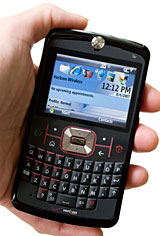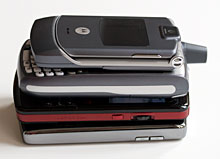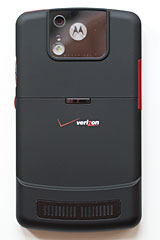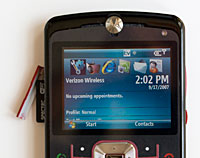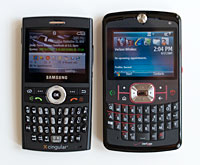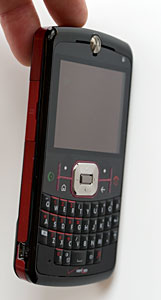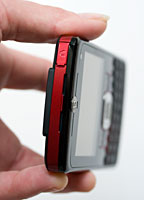
|
||||||||||
Like the Q, the Q9m has EVDO Rev. 0 for data, and not the faster Rev. A. Unless you'll be tethering the phone as a wireless modem for a notebook, Rev. 0 is more than adequate in terms of speed. The phone averaged 350k to 650k on DSLReports.com mobile speed test. The Q9m, like all Windows Mobile 6 smartphones comes with Internet Explorer Mobile for web browsing and Messaging (the mobile version of Outlook) for email, including push email via MS Direct Push and Exchange 2003SP 2 or newer. The phone can be used as a wireless modem for a computer, though Verizon charges extra for tethering. 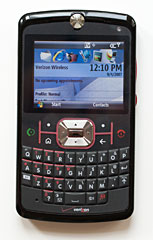
The Q9m lacks WiFi, though we didn't find ourselves hankering for it given Verizon's speedy and near-ubiquitous EVDO service. But for those who hope to buy this phone and use it without Verizon's $45/month data plan, there is hope. The Moto's miniSD card slot is side-loading (not under the battery or back door) and it supports SDIO, so you can use Spectec's miniSD WiFi card with the phone (if your card didn't ship with a Q9 driver, you can download it from Spectec's web site here).
The Spectec miniSD WiFi card in the Q 9m. Horsepower and Performance The Q9m has usual standard 64 megs of RAM and 128 megs of flash memory. Storage space would seem acceptable were it not for the GSM version (Q9h) and its 256 megs which leaves us feeling gypped. The 64 megs of RAM is used like RAM in your computer and flash memory is for storage (~64 megs are free for your use). CPU specs are unchanged from the Q: a 312MHz Intel XScale processor. There are several 200MHz Windows Mobile smartphones on the market, so the Q9m should be one of the leaders. It does indeed feel faster than the T-Mobile Dash, but not as much as we expected. This isn't to say the Moto is a slug; in fact we found its performance absolutely acceptable. But we did hope for faster performance given the CPU speed and the resulting battery life reduction. We found ourselves saying the same thing about the original Q when we first reviewed it, and to Motorola's credit, the Q9m feels faster than the Q. Compared to the Dash and other 200MHz Windows Mobile devices, video playback is smoother and faster. Display and Multimedia The Motorola Q9m has a sharp, bright and colorful QVGA display. The landscape oriented display's 320 x 240 resolution is viewable outdoors, and advantage non-touch screen smartphones have over their bigger Windows Mobile Pocket PC brethren. The phone has a smart backlight setting which should adjust display brightness relative to ambient lighting, though we found it stayed consistently bright, even in a dimly lit room.
The Samsung BlackJack and the Motorola Q 9m With its music moniker, you'd expect this to be a full-fledged ipod-hating multimedia phone. Music is indeed decent on the phone but its more like a Q in a red dress pretending to be an iPod Classic. Stereo speakers on the back give very good sound by cell phone standards, and that's about the only nod to music-centric hardware design. Windows Mobile phones have strong multimedia features out of the box, including Windows Media Player Mobile, a memory expansion slot and a good selection of 3rd party audio and video players on the market. The Q9m has all this, and that's great, though it means there's nothing phenomenally different between it and several other competing Windows Mobile phones currently on the market. Verizon has added two things, one bad and one good: access to their online music store, a first for a Verizon PDA or smartphone (that's the good thing); and a customized home screen that's not terribly attractive, isn't easy to navigate or see and gets in the way of the usual useful business stuff we see on the regular home screen (you guessed it, this is the bad thing). Happily, you can switch back to a standard Microsoft or Verizon home screen and escape the wacky red multimedia home screen. Sound quality through Motorola's wired stereo headphones (sadly not included) is excellent. And no surprise that the Motorola S9 stereo Bluetooth headphones performed better with the Moto Q9m than any other brand of phone. Sound through these headphones was excellent, though bass isn't their strong point (small in-the-ear drivers lack the punch of over-the-ear designs). Likely you won't be disappointed by the phone's sound quality via wired or Bluetooth wireless stereo headphones. Video playback is a bit better than average for Windows Mobile smartphones, which generally have trouble with anything more than low bitrate files. The phone does not support Verizon's VCast service, so you'll have to get a hold of video content other ways.
Bluetooth The Q9m has Bluetooth 2.0 and supports a good set of profiles by Verizon standards. It works with headsets over headset and handsfree profiles, as well as car kits. A2DP and AVRC are there for stereo Bluetooth headphones and headsets, such as the Moto S9. The phone can be used as a wireless modem for a PC (Verizon charges extra for this), and it uses the Bluetooth PAN profile. The Q also supports the HID profile (external Bluetooth keyboards being the most common HID device) and ActiveSync over Bluetooth. Motorola includes a Bluetooth file transfer application, that allows you to select from various categories of files to send (voice notes, ringtones, audio files and more). Should you prefer to choose from any and all files on the device, use the File Manager to browse to the file and select Send->Bluetooth. Motorola also includes a Bluetooth PC Remote Control program, which is fairly uncommon on phones (there are 3rd party apps for Nokia and Sony Ericsson but not factory software on most). This application allows you to control a Bluetooth enabled PC to do things like give a PowerPoint presentation or control music playback on the PC.
Battery Nothing to brag about here: battery life isn't the Q9m's strong point, nor was it the original Q's. The 1170 mAh Lithium Ion battery lasted us 1.5 days on a charge with moderate use, and 3 days with light use. If you spend quite a bit of time on the phone each day (1 hour or more) and use EVDO for an hour per day and turn on push email, charge it nightly. The faster CPU eats power (even though it doesn't propel the Q9 forward in performance) and the slim design means no space for a large battery. Such is life in the (semi) fast and slim lane. MP3 playback with the screen off won't use much power, and we found the Q good for 6 hours of music playback (with no other use).
Conclusion A definite improvement over the original Moto Q. The Q music 9m is attractive, slim and looks like an expensive, well made piece of electronics-- it definitely outshines the BlackBerry Curve and Samsung BlackJack in the high-class gear department. Responsiveness and overall CPU performance are average for a smartphone (better than the Q which was a bit slow), memory is adequate even though the Q9m's GSM cousin shows it up, and the screen is luscious and legible. We love the keyboard, which raises the bar for QWERTY candy bar phones: key size, doming and texture are excellent. The 1.3MP camera isn't the smartphone's strong point, and again the GSM version beats it. Though the music marketing overstates the case, the Music 9m as Verizon calls it does have a great set of stereo speakers (by phone standards), plays well with Bluetooth stereo headsets and supports high capacity miniSD cards for carrying lots of tunes. Pro: Great looks and excellent build quality. Nice display, wonderful keyboard. The more capable Documents To Go is included rather than the standard Windows Mobile Office apps. Con: Battery life is so-so. less flash memory and lower resolution camera compared to the GSM version. Web sites: www.motorola.com, www.verizonwireless.com Price: $199 with 2 year contract
| ||||||||||
